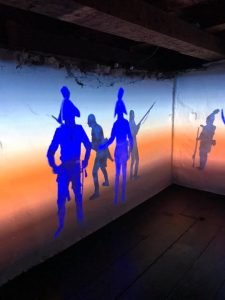Just over 200 years ago, Lieutenant Porter Hanks of the U.S. Regiment of Artillery awoke to a particularly unpleasant surprise. As July 17, 1812 dawned, Hanks learned that not only was the United States at war with Great Britain, but, more concerning, that a force of 600 British soldiers, Native American warriors, and Canadian militiamen stood poised to attack Fort Mackinac.

War fever had been building since early in the year, but when Congress declared war on Britain in June 1812, no message was sent to Hanks and his small garrison of American artillerymen at Fort Mackinac, one of the most isolated outposts of the U.S. military. Although Hanks grew suspicious of the large groups of indigenous men passing Mackinac Island on their way north towards the British post of Fort St. Joseph, he remained unaware of their intentions. In fact, they were responding to a British call for assistance, and were massing on St. Joseph’s Island, just 40 miles away from Mackinac Island. Only July 16 these indigenous men joined Canadian militia forces and a few British regular soldiers under the command of Captain Charles Roberts as they paddled towards Mackinac. Landing on the northwestern side of the island around 3:00 AM on July 17, Roberts and his forces dragged a 6-pound cannon overland to the heights just north of Fort Mackinac, all without alerting Hanks or his garrison. By 10:00 AM, with his men in place, Roberts sent Hanks a note demanding that he immediately surrender Fort Mackinac “to save the effusion of blood, which must of necessity follow the attack of such Troops as I have under my Command.” This thinly-veiled reference to Roberts’ indigenous allies, as well as the overwhelming odds (Hanks commanded only 61 artillerymen to Roberts’ more than 600 troops), convinced Hanks to surrender without resistance. The fall of Fort Mackinac marked the beginning of the War of 1812 in the Great Lakes, as well as a series of stinging American defeats across the Michigan Territory. Not until July 1815 would American troops return to Mackinac, and then only thanks to the peace treaty which ended the war.

This, one of the most dramatic events in Fort Mackinac’s history, is the focus of a new exhibit in the fort’s North Blockhouse. A short but immersive video program plunges visitors into the fear and confusion felt inside the fort as Hanks and his men realized their perilous situation on July 17, 1812. We hope you’ll join us this summer to experience this new exhibit, which is just one of several new interpretive elements on Mackinac Island. Elsewhere inside the fort, visitors can explore the renovated Office exhibit, while outside the new Mackinac Island Botanical Trail links the fort with Arch Rock. Visit Fort Mackinac to see these new exhibits and much more.









